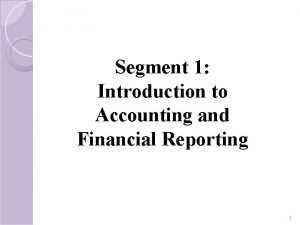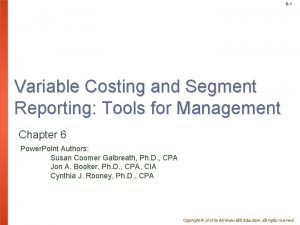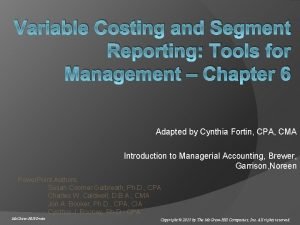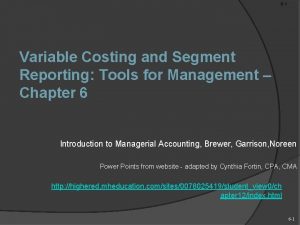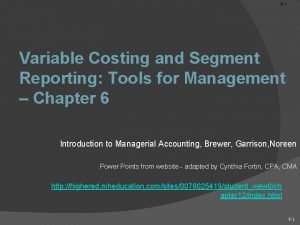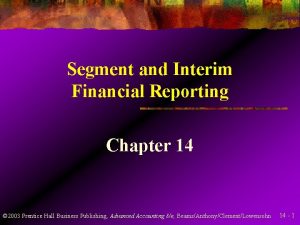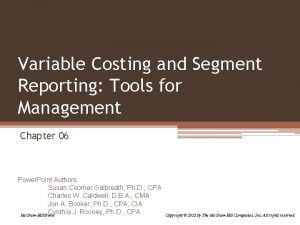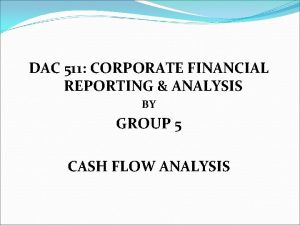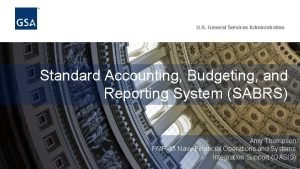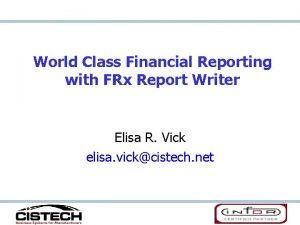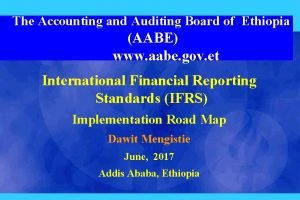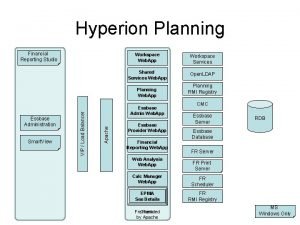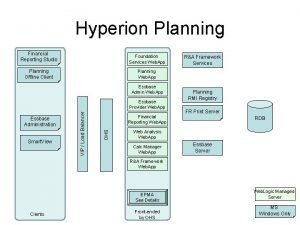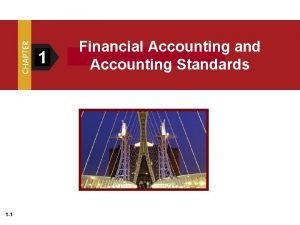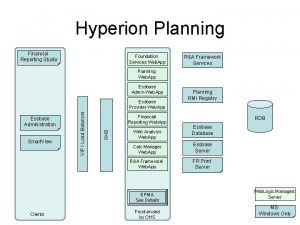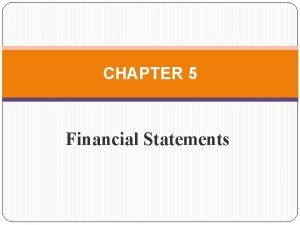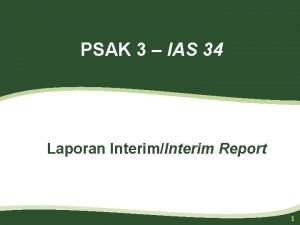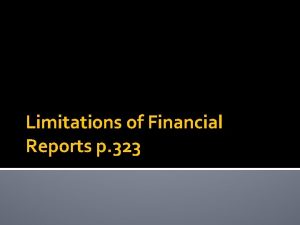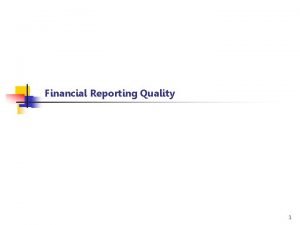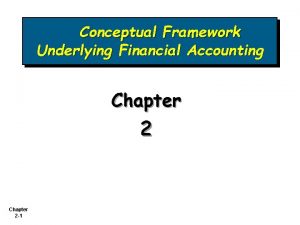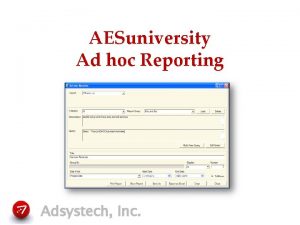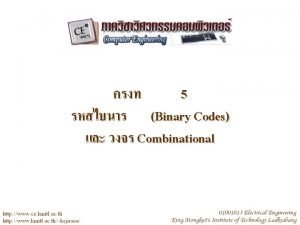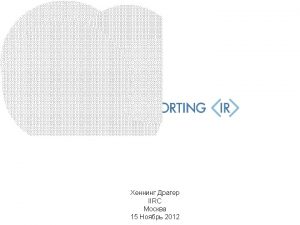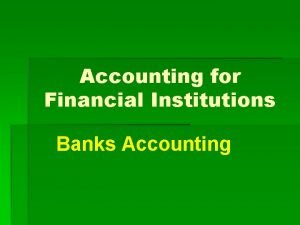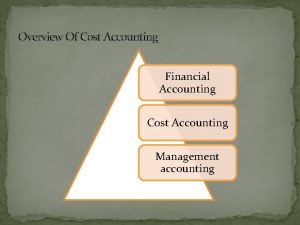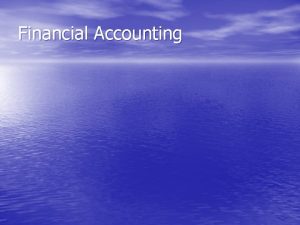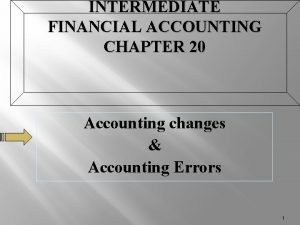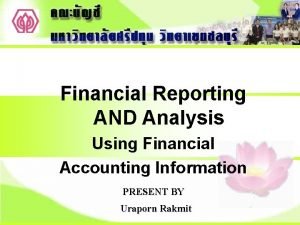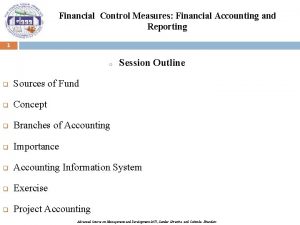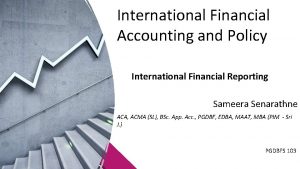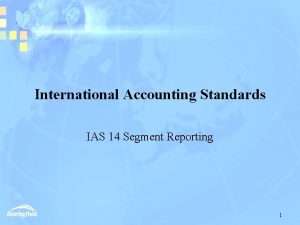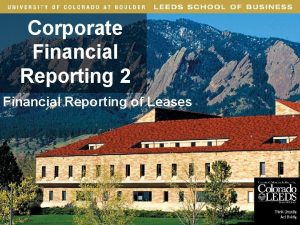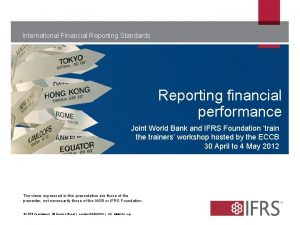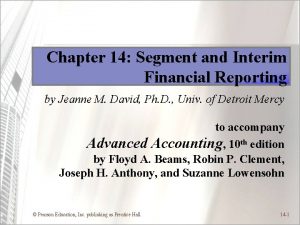Segment 1 Introduction to Accounting and Financial Reporting
































- Slides: 32

Segment 1: Introduction to Accounting and Financial Reporting 1

Function of Accounting The key functions of accounting throughout history have not changed: Accounting provides a record of transactions (internal control). Accounting provides a means of measuring success or failure (income determination). Accounting provides information for decision making. 2

What is GAAP? • Generally Accepted Accounting Principles • GAAP are a dynamic set of both broad and specific guidelines that companies should follow when reporting the information in their financial statements. Therefore, all companies’ financial statements are set up the same. • Financial Accounting Standards Board § Current rule-Body that makes the rules of accounting § Make decisions--Statements of Financial Accounting Standard 3

Historical Perspectives Pressures on the accounting profession to establish uniform accounting standards began to surface after the stock market crash of 1929. Some feel that insufficient and misleading financial statement information led to inflated stock prices and that this contributed to the stock market crash and the subsequent depression. The 1933 Securities Act and the 1934 Securities Exchange Act were designed to restore investor confidence. The 1933 act sets forth accounting and disclosure requirements for initial offerings of securities (stocks and bonds). In the 1934 act, Congress gave the SEC both the power and responsibility for setting accounting and reporting standards for companies whose securities are publicly traded. The SEC has the authority to set accounting standards for companies, but has delegated the responsibility to the accounting profession. 4

Early Standard Setting The first private sector body to assume the task of setting accounting standards was the Committee on Accounting Procedure (CAP). The CAP was a committee of the American Institute of Accountants (AIA). The AIA, which was renamed the American Institute of Certified Public Accountants (AICPA) in 1957, is the national organization of professional public accountants. From 1938 to 1959, the CAP issued 51 Accounting Research Bulletins (ARBs) which dealt with specific accounting and reporting problems. No theoretical framework for financial accounting was established. This approach of dealing with individual issues without a framework led to stern criticism of the accounting profession. In 1959 the Accounting Principles Board (APB) replaced the CAP. Members of the APB also belonged to the AICPA. The APB operated from 1959 through 1973 and issued 31 Accounting Principles Board Opinions (APBOs), various Interpretations, and four Statements. The Opinions also dealt with specific accounting and reporting problems. Many ARBs and APBOs have not been superseded and still represent authoritative GAAP. 5

Current Standard Setting Criticism of the APB led to the creation in 1973 of the Financial Accounting Standards Board (FASB). The FASB differs from its predecessor in many ways. There are seven full-time members of the FASB, compared to 18– 21 part-time members of the APB. While all of the APB members belonged to the AICPA, FASB members represent various groups concerned with accounting standards. Members have included representatives from the accounting profession, profit-oriented companies, accounting educators, and government. The Financial Accounting Foundation (FAF) is responsible for selecting the members of the FASB and its Advisory Council, ensuring adequate funding of FASB activities, and exercising general oversight of the FASB’s activities. The FASB is, therefore, an independent, private sector body whose members represent a broad ranges of interest groups. In 1984, the FASB’s Emerging Issues Task Force (EITF) was formed to provide more timely responses to emerging financial reporting issues. The Emerging Issues Task Force (EITF) identifies financial reporting issues and attempts to resolve them without involving the FASB. 6

Conceptual Framework of Accounting The Financial Accounting Standards Board (FASB), together with the International Accounting Standards Board (IASB), has embarked on a project to rebuild the foundations of financial reporting by revising the Conceptual Framework. The Conceptual Framework is like a constitution for financial reporting, providing the foundation for standards. The Conceptual Framework provides structure to the process of creating financial reporting standards and ensures that standards are based on fundamental principles. Without a framework, accounting standards might be based on the most expedient solution to a particular issue, rather than a solution that is consistent with a unified theory of accounting. The Conceptual Framework is an essential element in the development of principles-based accounting standards. The Conceptual Framework makes standards setting more efficient by providing a common set of terms and premises for analyzing accounting issues. Each time a debate on an accounting issue arises, it isn’t necessary to reinvent the wheel. FASB and the IASB expect a common Conceptual Framework to promote the convergence of U. S. GAAP and International Financial Reporting Standards (IFRS), ultimately leading to a single set of high-quality global accounting standards. 7

Summary of Setting GAAP Graphic 1 -2 summarizes order of authority for setting accounting standards. Congress gave the SEC the responsibility and authority to set accounting standards, specifically for companies whose securities are publicly traded. The SEC has delegated the task to various private sector bodies (currently the FASB) while retaining its legislated authority. 8

Classifications of Business Types For federal tax purposes there are only 6 forms of business organizations: Sole Proprietor (1040 Schedule C), Corporation (1120), Partnership (1065), S-Corporation (1120 S), Trust (1041), and Non-profit organization (990) 9

Sole Proprietors A sole proprietor is one person who owns, operates and takes the risks for a business. A sole proprietor is an unincorporated business and the owner assumes unlimited liability. There are no forms you need to fill out to start this type of business. The only thing you need to do is report your business income and expenses on your Form 1040 Schedule C. This is the easiest form of business to set up, and the easiest to dissolve. 10

Corporations are incorporated. Every form of business besides the sole proprietor is considered a separate entity, and this often provides a measure of legal and financial protection for the shareholders. The shareholders of corporations have limited liability protection, and corporations have full discretion over the amount of profits they can distribute or retain. Corporations are presumed to be for-profit entities. Corporations must have at least one shareholder. 11

Partnerships are unincorporated businesses. Like corporations, partnerships are separate entities from the shareholders. Unlike corporations, partnerships must have at lease one General Partner who assumes unlimited liability for the business. Partnerships must have at least two shareholders. Partnerships distribute all profits and losses to their shareholders without regard for any profits retained by the business for cash flow purposes. 12

S-Corporations and Trusts S-Corporations have features similar to a partnership. An Scorporation must have at least one shareholder, and cannot have more than 100 shareholders. If any shareholder provides services to the business, the S-Corp must pay that shareholder a reasonable salary. This salary is a separate payment from distributions of profits or losses. Trusts are usually formed upon the death of an individual and are designed to provide continuity of the investments and business activities of the deceased individual. 13

Non-Profits Nonprofits are corporations formed for a charitable, civic, or artistic purpose. Nonprofits are generally exempt from federal and state taxation on their income, and so they are often called "exempt organizations. " Nonprofits have substantial responsibilities for reporting their activities, income, and assets to ensure that they are in compliance with federal and state laws governing charities. 14

Types of Business Functions • Merchandising § Buy and sell products • Service § Provide service • Manufacturing § Make and sell products 15

THE ACCOUNTING EQUATION 16

RECEIVING CASH Transaction 1 August 1. Received cash from owner as an investment, $5, 000. After each transaction, the accounting equation must remain in balance. Capital is the amount an owner has invested in a business.

PAYING CASH Transaction 2 August 3. Paid cash for supplies, $275. 00. When two asset accounts are changed in a transaction, there must be an increase and a decrease. Transaction 3 August 4. Paid cash for insurance, $1, 200. 18

TRANSACTIONS ON ACCOUNT Transaction 4 August 7. Bought supplies on account from Supply Depot, $500. Transaction 5 August 11. Paid cash on account to Supply Depot, $300. 19

REVENUE TRANSACTIONS Transaction 6 August 12. Received cash from sales, $295. 00. Transaction 7 August 12. Sold services on account to Oakdale School, $350. 00. 20

EXPENSE TRANSACTIONS Transaction 8 August 12. Paid cash for rent, $300. Transaction 9 August 12. Paid cash for telephone bill, $40. 00. An expense is a decrease in owner’s equity resulting from the operation of a business. 21

OTHER CASH TRANSACTIONS Transaction 10 August 18. Received cash on account from Oakdale School, $200. Transaction 11 August 18. Paid cash to owner for personal use, $125. 00. A withdrawal by the owner will decrease both an asset and owner’s equity, but it should not be considered an expense. A withdrawal is actually an asset taken out of the business for personal use. 22

How Does Business Use Accounting Information? Marketing Pricing, distribution costs Human Resources Pay and fringe benefits, hiring costs Production and operations Production costs—actual and budgeted Finance Cost of borrowing, benefits expected from using the money 23

What are the 5 Basic Elements of Accounting? • Asset § Anything of value that is owned. (Cash, Accounts Receivable, Prepaid Insurance, Supplies, Inventory, Withdrawals) • Liability § An amount owed by a business. (Accounts payable, account name ends with the word “payable”) • Owners’ equity (Capital, Stocks, Retained Earnings, Sales, Expenses) § The amount remaining after the value of all liabilities is subtracted from the value of all assets. 24

5 Basic Elements Continued • Revenues § An increase in owner’s equity resulting from the operation of the business (sales). • Expenses § A decrease in owner’s equity resulting from the operation of a business. Amounts incurred in an attempt to generate revenues 25

What are the 5 Basic Financial Statements and Auditors’ Report? • Income statement § Indicates revenues less expenses = net income for a period of time. • Statement of cash flows § Indicates cash inflows and outflows from operating, investing, and financing activities for a period of time • Statement of shareholders/owners’ equity § Indicates changes in owners’ equity for a period of time (capital, investments, stocks, retained earnings, withdrawals). 26

Financial Statements Continued • Balance sheet § Indicates the ending balances of assets, liabilities, and owners’ equity (except revenues & expenses) at a point in time. • Auditor’s report § Indicates whether the company followed GAAP when preparing its financial statements. 27

Accrual Accounting Accrual accounting is the financial reporting model used by the majority of profit-oriented companies and by many not-for-profit companies. The fact that companies use the same model is important to financial statement users. Investors and creditors use financial information to make their resource allocation decisions. It’s critical that they be able to compare financial information among companies. To facilitate these comparisons, financial accounting employs a body of standards known as generally accepted accounting principles, of-ten abbreviated as GAAP (and pronounced gap). 28

Accrual Basis of Accounting Accrual is Periodic Basis—Transaction happens in one fiscal period but not paid/received until a later fiscal period. Accrued Expenses—Expenses incurred in one fiscal period but not paid until a later fiscal period. Accrued Interest Expense-Interest incurred in one fiscal period but not paid until a later fiscal period. Accrued Interest Income—Interest earned one fiscal period but not received until a later fiscal period. Accrued Revenue—Revenue earned one fiscal period but not received until a later fiscal period. 29

Current Ratio § Relationship between current assets and current liabilities. § A business wants their assets to be of a higher value than their liabilities. 30

Financial Analysis Faulkender Company Comparative Balance Sheet December 31, 2009 and 2008 2009 2008 Cash $ 22, 000 $ 20, 000 Accounts receivable 41, 500 39, 000 Inventory 72, 000 64, 000 Plant and equipment 288, 000 265, 000 Accumulated depreciation (80, 000) (72, 000) Total assets $343, 500 $316, 000 Accounts payable $ 24, 000 $ 37, 000 Wages payable 3, 500 4, 000 Taxes payable 6, 750 8, 500 Bonds payable 100, 000 Common stock 80, 000 Retained earnings 129, 250 86, 500 Total liabilities and stockholder’s equity $343, 500 $316, 000 ____________________________________ Faulkender Company Income Statement For the Year Ended December 31, 2009 Sales $400, 000 Cost of goods sold 248, 000 Gross margin $ 152, 000 Operating expenses: Selling expenses $39, 000 Rent expenses 45, 000 Depreciation expense 11, 000 Bad debt expensee 1, 715 Interest expense 15, 000 111, 715 Income from operations $ 40, 285 Loss on sale of equipment (1, 000) Income before taxes $ 39, 285 Income tax expense 11, 785 Net income $ 27, 500 Quick ratio for 2009: (cash + accounts receivables) / current liabilities ($22, 000+ $41, 500)/ ($24, 000+ $3, 500+ 6, 750) = 1. 85 Any account with the word “payable” in it, is a liability. 31

Chapter 1 Accounting Concepts Business Entity—A business’s financial information is recorded and reported separately from the owner’s personal financial information. Unit of Measurement—When business transactions are stated in numbers that have common values, such as dollars. Reality of Revenue—When revenue is recorded at the time goods or services are sold, such as when a sale occurs. LESSON 1 -2 32
 Segment reporting introduction
Segment reporting introduction Financial accounting chapter 1
Financial accounting chapter 1 Social and environmental accounting ppt
Social and environmental accounting ppt Earth segment and space segment
Earth segment and space segment Variable costing and segment reporting
Variable costing and segment reporting Variable costing and segment reporting tools for management
Variable costing and segment reporting tools for management Variable costing and segment reporting tools for management
Variable costing and segment reporting tools for management Variable costing and segment reporting tools for management
Variable costing and segment reporting tools for management Segment and interim reporting chapter 8
Segment and interim reporting chapter 8 Variable costing and segment reporting tools for management
Variable costing and segment reporting tools for management Personal scorecard
Personal scorecard Identifying market segments and targets
Identifying market segments and targets Segment reporting example
Segment reporting example Corporate financial reporting and analysis
Corporate financial reporting and analysis Standard accounting budgeting and reporting system
Standard accounting budgeting and reporting system Frx designer
Frx designer Accounting and auditing board of ethiopia proclamation
Accounting and auditing board of ethiopia proclamation Purpose of financial statements
Purpose of financial statements Financial reporting studio
Financial reporting studio Financial reporting studio
Financial reporting studio Us gaap conceptual framework
Us gaap conceptual framework The major key players on the international side are the:
The major key players on the international side are the: What is financial reporting studio?
What is financial reporting studio? Chapter 6 fge financial management
Chapter 6 fge financial management Cbd financial reporting framework
Cbd financial reporting framework Ias 34 interim financial reporting
Ias 34 interim financial reporting Project management financial reporting
Project management financial reporting Limitations of financial reporting
Limitations of financial reporting Chapter 2 conceptual framework for financial reporting
Chapter 2 conceptual framework for financial reporting International financial reporting standards 9
International financial reporting standards 9 Limitations of financial reporting
Limitations of financial reporting Fair value historical cost
Fair value historical cost What is ad hoc reporting in accounting
What is ad hoc reporting in accounting
